Extremely Severe Cyclonic Storm “Amphan” hits India and Bangladesh, leaving a trail of destruction
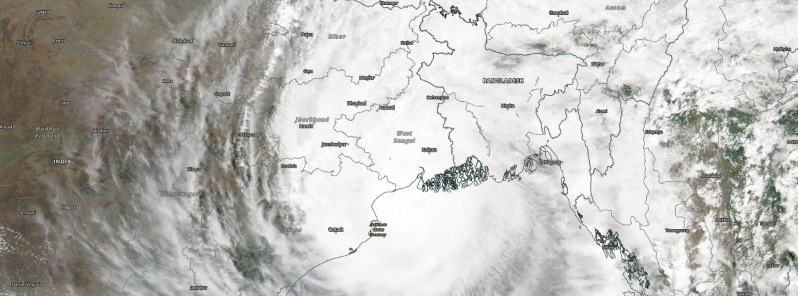
Extremely Severe Cyclonic Storm "Amphan" has left a trail of destruction in the state of Odisha before making landfall between Digha in West Bengal and Hatiya island in Bangladesh around 09:00 UTC (14:30 LT) on Wednesday, May 20, 2020. Around three million people in both countries have already been evacuated. Amphan is the first named storm of the 2020 North Indian Ocean cyclone season and the first super cyclonic storm in the Bay of Bengal since the 1999 Odisha cyclone. 2020 is the second year in a row featuring a super cyclonic storm, the previous year seeing Kyarr in the Arabian Sea.
At 10:00 UTC (15:30 LT), the cyclone was located over northwest Bay of Bengal, 70 km (44 miles) east of Digha, crossing West Bengal coast between Digha and Hatiya close to Sunderban with maximum sustained 3-minute wind speeds between 160 to 170 km/h (99 to 106 mph), gusting to 190 km/h (118 mph).
Storm surge of about 4 to 5 m (13 – 16 feet) above Astronomical Tide is likely to inundate low lying areas of south and north 24 Parganas and about 3 to 4 m (10 – 13 feet) over the low lying areas of East Medinipur District of West Bengal during the time of landfall.
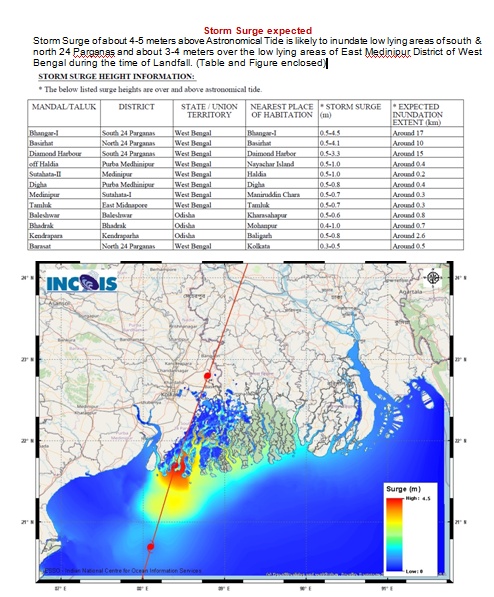
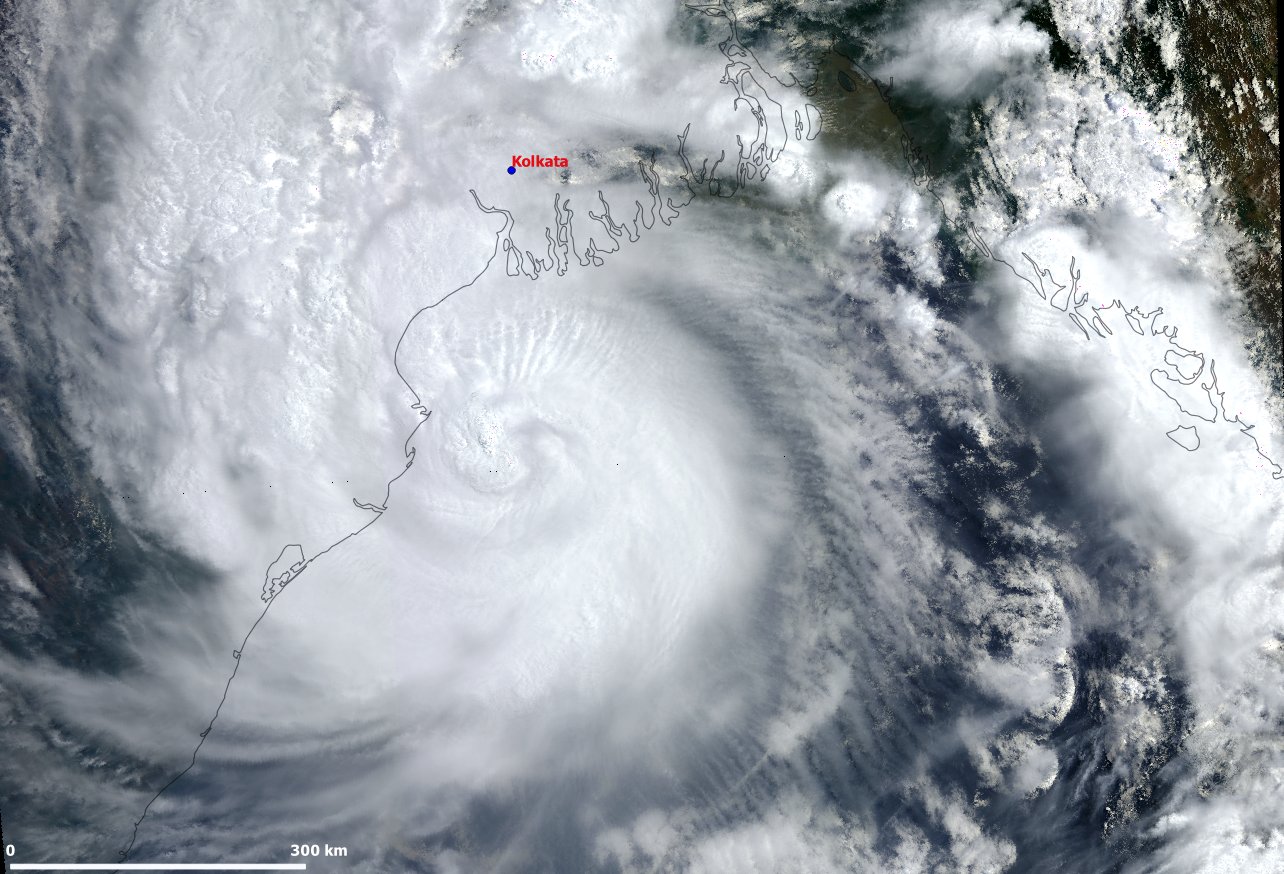
Tropical Cyclone "Amphan" at 04:06 UTC on May 20, 2020. Credit: Copernicus EU/Sentinel-3, Antonio Vecoli
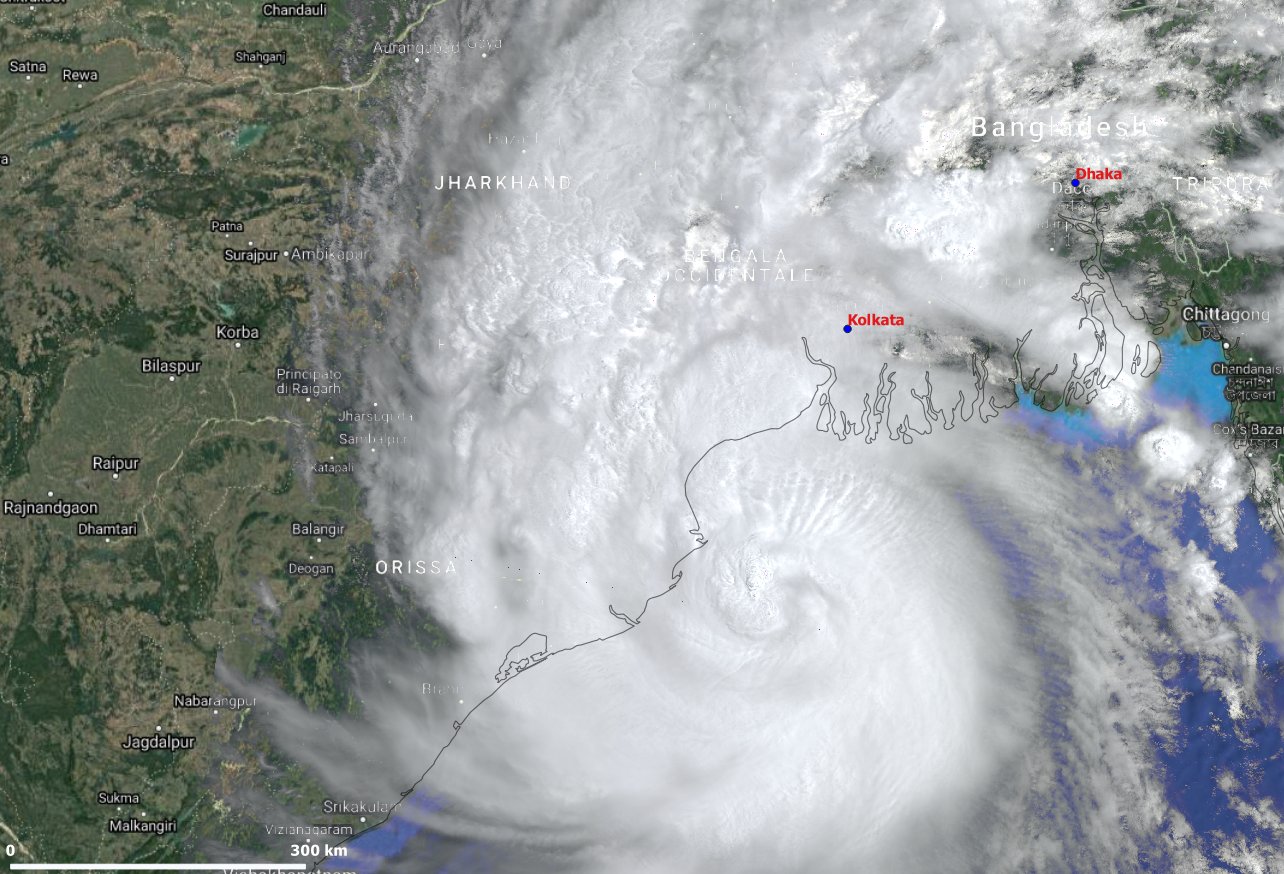
Tropical Cyclone "Amphan" at 04:06 UTC on May 20, 2020. Credit: Copernicus EU/Sentinel-3, Antonio Vecoli
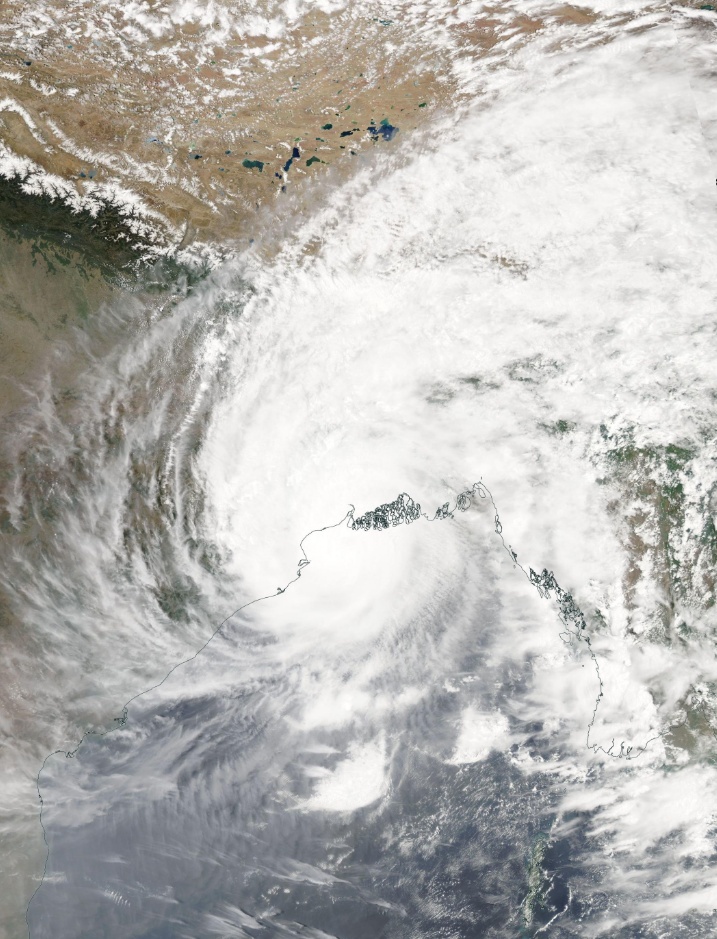
Tropical Cyclone "Amphan" on May 20, 2020. Credit: NASA Aqua/MODIS
Odisha government authorities reported two fatalities in the districts of Bhadrak and Kendrapara.
Three members of the same family sustained injuries when tree branches collapsed on their hose in Balasore. IMD senior bureaucrat said the state is facing wind speeds between 100 to 110 km/h (62 to 68 mph).
In Bangladesh, a Red Crescent volunteer died when a boat capsized while evacuating villagers in the path of the cyclone. "There were four of them on the boat when it sank," said Nurul Islam Khan, director of Cyclone Preparedness Program of the Bangladesh Red Crescent.
#AmphanSuperCyclone
Situation in Kanthi, West Bengal.#amphan #CycloneAmphanUpdate #CycloneAmphan #WestBengal pic.twitter.com/ALT5MOG4td— Ashish Ranjan Swain (@ashishrswain86) May 20, 2020
#CycloneAmphan makes #Landfall : the fury of #Amphan near Digha, West Bengal
Video credit : Shamit Bhoumik@PIBBhubaneswar #CycloneAmphanUpdate pic.twitter.com/JScKMfeDt1— PIB India #StayHome #StaySafe (@PIB_India) May 20, 2020
SUPER CYCLONE #AMPHAN #KOLKATA pic.twitter.com/ipLpXz9LqP
— Pritam Pramanick (@PRITAMP264) May 20, 2020
Video from Digha and Kolkata ( West Bengal) #Pray for the safety and well being of all those living in the costal areas of #Odisha and #Bengal .
Cyclone nearing landfall..very heavy rains lashing Kolkata now #kolkata #digha #amphan pic.twitter.com/BD5MLXlvS3
— Rajat Raj Gupta Bhaiya Ham Kanpuriya Hain (@RajatRajGupta8) May 20, 2020
#CycloneAmphan makes landfall in #WestBengal. Visuals from #South24Parganas #AmphanUpdates pic.twitter.com/68hdWsmwaD
— TOI Kolkata (@TOIKolkata) May 20, 2020
More than 600 000 people have been evacuated from vulnerable areas in West Bengal and Odisha solely. Around three million in India and Bangladesh have been evacuated to cyclone shelters.
Authorities said they are trying not to crowd the shelters to its full capacity in fears of catching the coronavirus. "We are fighting a war on two fronts," said police officer Rajesh Pandit. "First to evacuate people, and then to make sure that they don’t catch the infection."
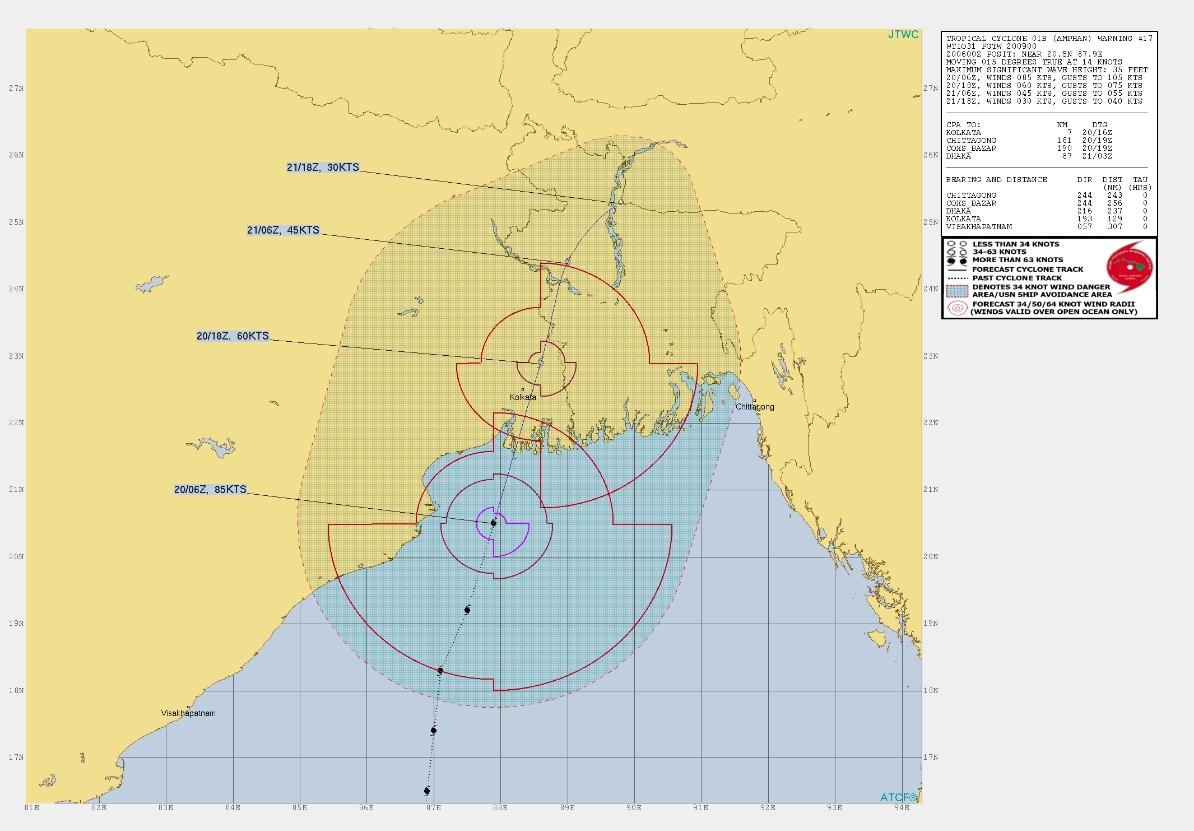
Image credit: JTWC
According to the India Meteorological Department (IMD), the landfall process, triggering copious rain and gusty winds in Odisha and Bengal, is expected to continue for around two to three hours and is very likely to keep moving north-northeastwards.
Amphan is forecast to pack wind speeds of 155 to 165 km/h (96 to 103 mph), gusting to 185 km/h (115 mph) for the next three hours before it weakens.
IMD director-general Mrutunjay Mohapatra added that Amphan will reach Kolkata by Wednesday evening (LT). Heavy rainfall warnings are in effect for Odisha, West Bengal, Sub-Himalayan West Bengal, Sikkim and Sikkim, and Assam and Meghalaya.
Ground report: Current situation of Haldia, #WestBengal, when #CycloneAmphan is making the landfall.#CycloneAmphanUpdate#CycloneAmphan #CycloneAmphanUpdates #AmphanCyclone #Amphan pic.twitter.com/5449eCTPNK
— SkymetWeather (@SkymetWeather) May 20, 2020
Ground report: Current situation of Medinipur, #WestBengal, when #CycloneAmphan is making the landfall.#CycloneAmphanUpdate#CycloneAmphan #CycloneAmphanUpdates #AmphanCyclone #Amphan pic.twitter.com/UFZ198a1Xu
— SkymetWeather (@SkymetWeather) May 20, 2020
#AmphanSuperCyclone #AmphanUpdate #Amphan Large tin sheets flying 60 ft up in the sky. pic.twitter.com/aXQihGWNl8
— An Indian (@indianssssssss) May 20, 2020
Millions evacuated in the midst of covid-19 crisis. #overlappinghazards and now Cyclone Amphan begins making landfall. https://t.co/Ocb6tIY8Vh
— Jen Spinney (@jspinney19) May 20, 2020
Strong winds and rain in Sundarbans. @Welthungerhilfe keeping track Video taken by @SRAN40039950 Nimpith #CycloneAmphan #CycloneAmphanUpdate pic.twitter.com/hvco0grPKj
— Nivedita Varshneya (@niveditavarshne) May 20, 2020
@ndtv @abpanandatv #Amphan #AmphanUpdate #amphankolkata #jadavpur
This led to instant blackout of Jadavpur area. Nothing stops force of nature! Stay home and stay safe! pic.twitter.com/bNEPjeCyWx
— Suraj Chakraborty (@surajc2006) May 20, 2020
Featured image: Tropical Cyclone "Amphan" on May 20, 2020. Credit: NASA Aqua/MODIS

Commenting rules and guidelines
We value the thoughts and opinions of our readers and welcome healthy discussions on our website. In order to maintain a respectful and positive community, we ask that all commenters follow these rules:
We reserve the right to remove any comments that violate these rules. By commenting on our website, you agree to abide by these guidelines. Thank you for helping to create a positive and welcoming environment for all.